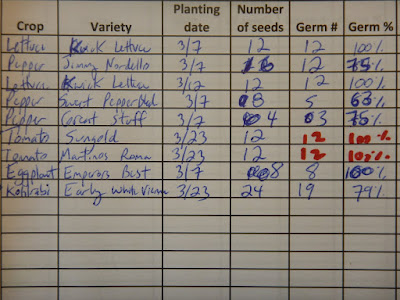Fast forward a few seasons... this year I am continuing a system I started last year:
- buy seeds early
- for long-season crops, plant them indoors on time
- transplant or direct seed outdoors as early as possible
These practices allow me to not only plant unique or delicious varieties that will grow well in Wisconsin, but by planting early I can extend my growing season and maximize on my rotations (early crops, mid/late season crops, and fall crops).
Right now my system is not so fancy: shelves in a bright, southern window with a few grow lights hung to provide extra light in the morning and evenings. In the future I want to build one of these babies:

But for now, I'll work with what I have. I started some onions two weeks ago (in the back) and my current batch of microgreens (in the front):

I ran across the very handy University of Wisconsin's regional planting guide (starting on page 5) that lets me know when to start different plants indoors and outdoors. It is fantastic and I'm not sure how I grew vegetables without it. I would guess most locations have a similar resource (in the US, a good first step would be to check with your local university extension agent).
For the second year in a row I am also writing down the varieties I grow, how many seeds I start, and what the germination percentage is. This is helpful for next year to know how much to plant and whether I should plant extra seeds to get the desired number of plants. Some notes from 2015:

I'm also trying out the

So March is here and my first year of urban farming full time is off to a good start! I planted those onions on Valentine's Day, and today I started the peppers and eggplant. And although fat biking on the local pond is a ton of fun, I am ready for the snow to melt!

1 comment:
Great blog! Will follow it and -- who knows -- maybe we'll try our own version of this once we've learned a few things here. Thanks!
Post a Comment